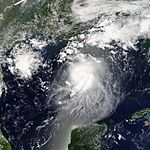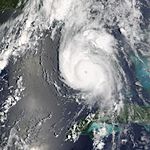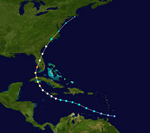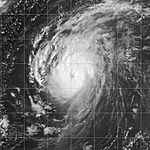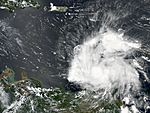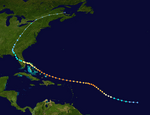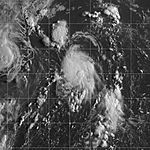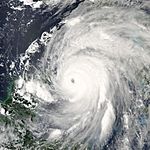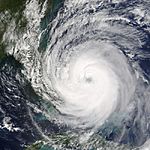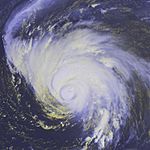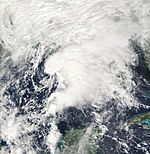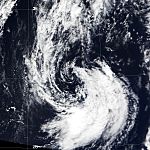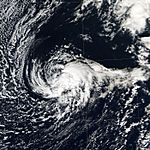2004 Atlantic hurricane season facts for kids
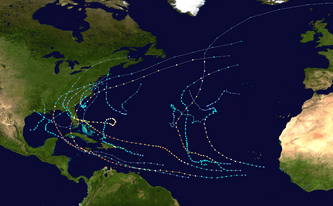 |
|
| First storm started: | July 31, 2004 |
| Last storm ended: | December 3, 2004 |
| Strongest storm: | Hurricane Ivan - 910 mbar, 165 mph winds |
| Number of storms: | 15 named storms |
| Major hurricanes (Cat. 3+) | 6 |
| Cost of damage: | $42 billion (2004 USD) $44.9 billion (2006 USD) |
| People killed: | 3,132+ |
The 2004 Atlantic hurricane season was a busy time for storms. It officially started on June 1, 2004, and ended on November 30. These dates are when most tropical storms and hurricanes usually form in the Atlantic Ocean. However, the 2004 season had a storm, Tropical Storm Otto, that lasted into December.
This season had more activity than usual. There were fifteen named storms. It also had one of the highest "Accumulated Cyclone Energy" totals ever recorded. This means the storms were very strong and lasted a long time. Some of the most well-known storms that year were Hurricane Charley, Frances, Ivan, and Jeanne.
Contents
- Storms of 2004
- Hurricane Alex
- Tropical Storm Bonnie
- Hurricane Charley
- Hurricane Danielle
- Tropical Storm Earl
- Hurricane Frances
- Hurricane Gaston
- Tropical Storm Hermine
- Hurricane Ivan
- Tropical Depression Ten
- Hurricane Jeanne
- Hurricane Karl
- Hurricane Lisa
- Tropical Storm Matthew
- Subtropical Storm Nicole
- Tropical Storm Otto
- Storm Names
- Images for kids
- See also
Storms of 2004
Hurricane Alex
| Category 3 hurricane (SSHS) | |||
|---|---|---|---|
|
|||
| Duration | July 31 – August 6 | ||
| Intensity | 120 mph (195 km/h) (1-min), 957 mbar (hPa) | ||
Hurricane Alex formed on July 31 near the coast of South Carolina. It quickly grew stronger, becoming a Category 2 hurricane. On August 3, Alex came very close to North Carolina, about 10 miles away. After that, Hurricane Alex moved northeast and faded away in the middle of the Atlantic Ocean. Since Alex did not hit land directly, it caused less damage. It led to about $2.4 million in damage and one death.
You can find official forecasts for Hurricane Alex from the NHC here.
Tropical Storm Bonnie
| Tropical storm (SSHS) | |||
|---|---|---|---|
|
|||
| Duration | August 3 – August 13 | ||
| Intensity | 65 mph (100 km/h) (1-min), 1001 mbar (hPa) | ||
Bonnie started as a tropical depression east of Barbados. It moved across the Windward Islands and weakened. Later, it became a tropical depression again south of Cuba. Tropical Storm Bonnie then made landfall in the Florida Panhandle. After hitting land, Bonnie weakened and disappeared. Bonnie caused about $1 million in damage and led to four deaths.
You can find official forecasts for Tropical Storm Bonnie:
- from the NHC here.
- from the HPC here after it moved over land.
Hurricane Charley
| Category 4 hurricane (SSHS) | |||
|---|---|---|---|
|
|||
| Duration | August 9 – August 14 | ||
| Intensity | 150 mph (240 km/h) (1-min), 941 mbar (hPa) | ||
Hurricane Charley was a very powerful hurricane that grew stronger very quickly. It also hit land further south than expected. Charley caused a huge amount of damage, about $16.5 billion, and led to 35 deaths. At the time, it was the second most expensive storm in U.S. history, after Hurricane Andrew. However, other storms like Hurricane Katrina, Hurricane Wilma, and Hurricane Ike later caused even more damage. This made Charley the fifth costliest storm in U.S. history.
You can find official forecasts for Hurricane Charley from the NHC here.
Hurricane Danielle
| Category 2 hurricane (SSHS) | |||
|---|---|---|---|
|
|||
| Duration | August 13 – August 21 | ||
| Intensity | 110 mph (175 km/h) (1-min), 964 mbar (hPa) | ||
Danielle was a Category 2 hurricane in 2004. It formed on August 13 in the far eastern Atlantic Ocean. As it moved, it passed over cooler waters. This caused Danielle to weaken and disappear by August 21.
You can find official forecasts for Hurricane Danielle from the NHC here.
Tropical Storm Earl
| Tropical storm (SSHS) | |||
|---|---|---|---|
|
|||
| Duration | August 13 – August 15 | ||
| Intensity | 50 mph (85 km/h) (1-min), 1009 mbar (hPa) | ||
Tropical Depression Five formed on August 13. The next day, it became Tropical Storm Earl. Tropical Storm Earl passed south of Grenada and then weakened into a tropical wave. Its remains later became Hurricane Frank in the Pacific Ocean. You can learn more about Earl's path after it crossed oceans in the 2004 Pacific hurricane season article.
Hurricane Frances
| Category 4 hurricane (SSHS) | |||
|---|---|---|---|
|
|||
| Duration | August 25 – September 8 | ||
| Intensity | 145 mph (230 km/h) (1-min), 935 mbar (hPa) | ||
Hurricane Frances was one of four hurricanes that greatly affected the U.S. state of Florida in 2004. Frances made landfall near the same place where Hurricane Jeanne would hit about two weeks later. Frances also caused about 101 tornadoes, stretching from Florida all the way to Virginia. This storm killed 49 people and caused $12 billion in damage.
You can find official forecasts for Hurricane Frances:
- from the NHC here.
- from the HPC here after it moved over land.
Hurricane Gaston
| Category 1 hurricane (SSHS) | |||
|---|---|---|---|
|
|||
| Duration | August 27 – September 1 | ||
| Intensity | 75 mph (120 km/h) (1-min), 985 mbar (hPa) | ||
Gaston began as Tropical Depression Seven on August 27. It grew into a tropical storm. Then, it briefly strengthened into a hurricane just before hitting land in South Carolina on August 29. On August 30, it moved back into the Atlantic Ocean. Gaston faded away on September 1. It caused nine deaths and about $120 million in damage.
Tropical Storm Hermine
| Tropical storm (SSHS) | |||
|---|---|---|---|
|
|||
| Duration | August 27 – August 31 | ||
| Intensity | 60 mph (95 km/h) (1-min), 1002 mbar (hPa) | ||
Hermine started about 360 miles south of Bermuda. It moved west and became a tropical storm. Hermine quickly moved north and made landfall on August 31. It hit New Bedford, Massachusetts as a weak tropical storm. Hermine disappeared on the same day, causing no deaths and only a small amount of damage.
Hurricane Ivan
| Category 5 hurricane (SSHS) | |||
|---|---|---|---|
|
|||
| Duration | September 2 – September 24 | ||
| Intensity | 165 mph (270 km/h) (1-min), 910 mbar (hPa) | ||
Hurricane Ivan was the strongest hurricane of the 2004 Atlantic hurricane season. It formed in early September. Ivan became the ninth named storm, the sixth hurricane, and the fourth major hurricane of the year. Ivan reached Category 5 strength on the Saffir-Simpson Hurricane Scale. This is the highest possible category and Ivan was the only storm to reach it that season. At the time, it was the sixth most intense Atlantic hurricane ever recorded.
You can find official forecasts for Hurricane Ivan:
- from the NHC here.
- from the HPC here after it moved over land.
Tropical Depression Ten
| Tropical depression (SSHS) | |||
|---|---|---|---|
|
|||
| Duration | September 7 – September 9 | ||
| Intensity | 35 mph (55 km/h) (1-min), 1009 mbar (hPa) | ||
Tropical Depression Ten was the only tropical depression in the 2004 Atlantic hurricane season that didn't become a named storm. It formed in the northeast Atlantic on September 7. It disappeared two days later. Tropical Depression Ten did not affect any land areas.
You can find official forecasts for Tropical Depression Ten from the NHC here.
Hurricane Jeanne
| Category 3 hurricane (SSHS) | |||
|---|---|---|---|
|
|||
| Duration | September 13 – September 28 | ||
| Intensity | 120 mph (195 km/h) (1-min), 950 mbar (hPa) | ||
Hurricane Jeanne was a very deadly storm, especially for Haiti. The storm caused 3,035 deaths, with about 3,006 of those in Haiti alone. Hurricane Jeanne was also a very costly hurricane. It caused $7 billion in damage, making it the 13th most expensive hurricane in U.S. history. In Florida, the hurricane hit the same area that Hurricane Frances had hit just two weeks before.
You can find official forecasts for Hurricane Jeanne:
- from the NHC here.
- from the HPC here after it moved over land.
Hurricane Karl
| Category 4 hurricane (SSHS) | |||
|---|---|---|---|
|
|||
| Duration | September 16 – September 24 | ||
| Intensity | 145 mph (230 km/h) (1-min), 938 mbar (hPa) | ||
Hurricane Karl was a strong Category 4 hurricane. It mainly affected the Faroe Islands. Karl formed in the middle of the Atlantic on September 16 as Tropical Depression Twelve. It became a tropical storm on the same day. Two days later, it became a hurricane. By September 21, it was a Category 4 storm and soon reached its highest winds of 145 mph. It continued north, getting weaker, and then changed into a non-tropical storm on September 24.
You can find official forecasts for Hurricane Karl from the NHC here.
Hurricane Lisa
| Category 1 hurricane (SSHS) | |||
|---|---|---|---|
|
|||
| Duration | September 19 – October 3 | ||
| Intensity | 75 mph (120 km/h) (1-min), 987 mbar (hPa) | ||
Lisa was a Category 1 hurricane. It stayed weak for most of its early life. After almost 14 days, it finally became a hurricane. Hurricane Lisa started on September 19 and disappeared on October 3.
You can find official forecasts for Hurricane Lisa from the NHC here.
Tropical Storm Matthew
| Tropical storm (SSHS) | |||
|---|---|---|---|
|
|||
| Duration | October 8 – October 10 | ||
| Intensity | 45 mph (75 km/h) (1-min), 997 mbar (hPa) | ||
Matthew was a weak tropical storm. It started in the Gulf of Mexico on October 8. Tropical Storm Matthew made landfall in Louisiana on October 10 and disappeared on the same day. The storm caused about $300,000 in damage.
You can find official forecasts for Tropical Storm Matthew:
- from the NHC here.
- from the HPC here after it moved over land.
Subtropical Storm Nicole
| Subtropical storm (SSHS) | |||
|---|---|---|---|
|
|||
| Duration | October 10 – October 11 | ||
| Intensity | 50 mph (85 km/h) (1-min), 986 mbar (hPa) | ||
Subtropical Storm Nicole was the only subtropical storm in 2004. Nicole formed on October 10 southwest of Bermuda. Subtropical Storm Nicole disappeared the very next day. Nicole caused large waves along the East Coast of The United States. It also brought almost 6 inches of rain to Bermuda.
You can find official forecasts for Subtropical Storm Nicole from the NHC here.
Tropical Storm Otto
| Tropical storm (SSHS) | |||
|---|---|---|---|
|
|||
| Duration | November 29 – December 3 | ||
| Intensity | 50 mph (85 km/h) (1-min), 995 mbar (hPa) | ||
Tropical Storm Otto formed late in the season, on November 29. On the same day, Tropical Storm Otto reached its strongest winds of 50 mph. Otto then disappeared on December 3.
You can find official forecasts for Tropical Storm Otto from the NHC here.
Storm Names
Here is the list of names that were planned for the 2004 Atlantic hurricane season. Names that were not used are marked as unused.
|
Retired Names
In the spring of 2005, four names from the 2004 season were "retired." This means they will never be used again for Atlantic hurricanes because the storms caused so much damage or loss of life. The retired names were Charley, Frances, Ivan, and Jeanne. In 2010, these names were replaced with Colin, Fiona, Igor, and Julia for future hurricane seasons.
|
Tropical cyclones of the 2004 Atlantic hurricane season |
||||||||||||||||||||||||||||||||
|
|
|
|||||||||||||||||||||||||||||||
|
|
||||||||||||||||||||||||||||||||
Images for kids
See also
 In Spanish: Temporada de huracanes en el Atlántico de 2004 para niños
In Spanish: Temporada de huracanes en el Atlántico de 2004 para niños




